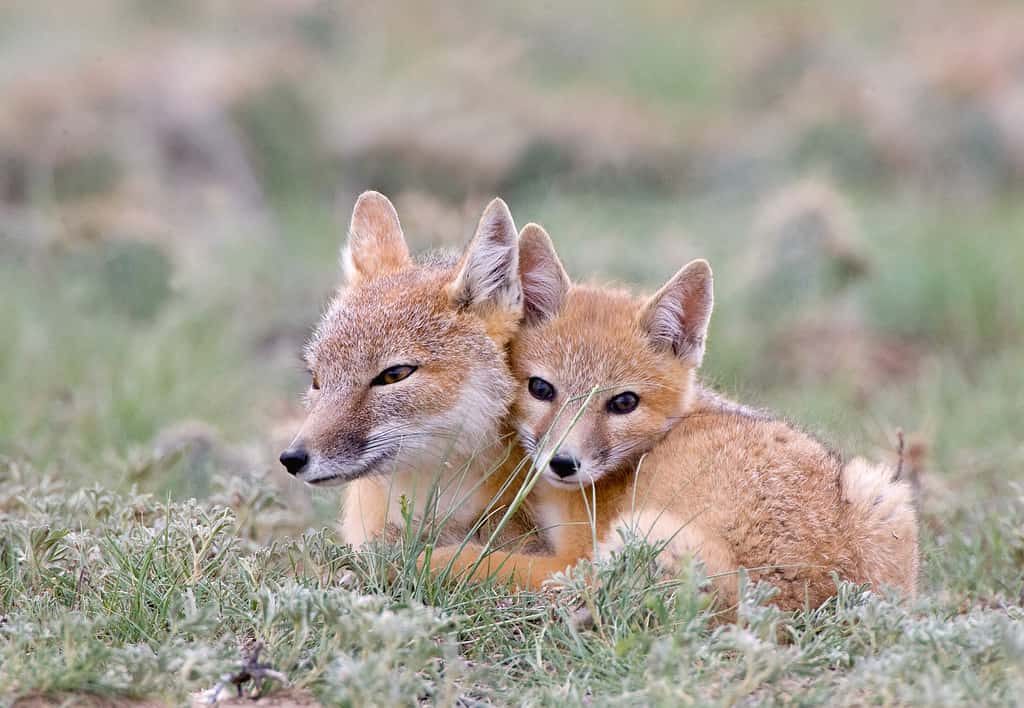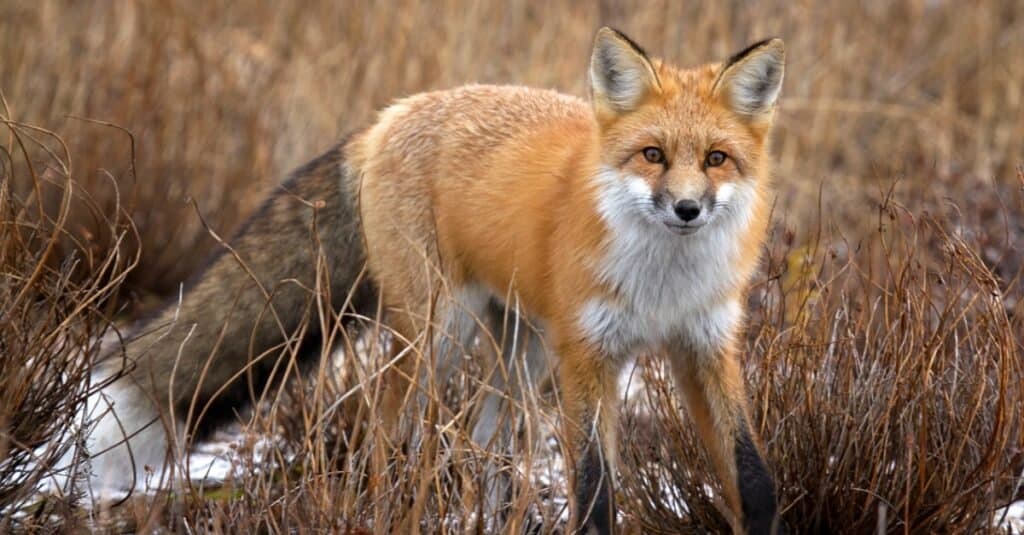Did you know that Nebraska boasts a population of almost 2 million people? Well, many other mammals also call this agricultural state home, including bears, cows, bighorn sheep, dogs, and their adaptable, determined – and ceaselessly sly – relatives, foxes!
If you’re a big fan of canines, foxes must be on your radar. Almost friendly as humans, these animals come with pointed ears, long muzzles, slender bodies, and bushy tails. Sometimes, their curiosity is off the charts, and they will shyly approach you when they see you. And yet, despite being wild, they don’t pose any threat, explaining why some pet owners prefer them to dogs.
Foxes are also incredibly adaptable, allowing them to thrive in almost any environment, including different regions in Nebraska. Several types are known to roam this state, including the swift and red fox. Are you eager to know where you can go to catch sight of or observe them? Keep reading to find out and learn about hunting and caring for these cunning but gorgeous members of the dog family Canidae.

The swift fox is nearly the same size as a
domestic cat
, with a dark grayish tan on the back and buff orange on the sides and legs
©en:User:Cburnett / CC BY-SA 3.0 – License
Swift Fox (Vulpes velox)
The swift fox is typically found in western Nebraska’s shortgrass prairies and is among the smallest species. An adult weighs 2-3 kilograms and is roughly 30 cm tall and 79-80 cm long. The canine is nearly the same size as a domestic cat, with a dark grayish tan on the back and buff orange on the sides and legs. Its throat and chest are cream, and you can see black patches on both edges of its snout. In addition, the animal’s long, bushy tail comes with a distinctive black tip that makes it noticeable from afar.
Most people can’t distinguish between male and female swift foxes, but the former is usually larger. In the wild, these intelligent mammals survive 3-4 years. But in zoos or captivity, they live up to 14 years since they have limitless access to food, water, and healthcare. Furthermore, as their name suggests, they are incredibly fast and can easily reach speeds of more than 50 km/h—which allows them to flee when they see predators and catch prey.

This species’ population has significantly decreased due to habitat loss.
©Rob Palmer Photography/Shutterstock.com
Is the Swift Fox an Endangered Species?
Years ago, swift foxes were found in two-thirds of Nebraska. Sadly, this species’ population has significantly decreased. And it’s now in the pool of endangered animals due to habitat loss since only about 40% of the state has shortgrass prairies. Other threats include harsh winters, accidental or calculated poisoning, and deadly pathogens.
Thankfully, the Nebraska Game and Parks Commission collaborated with various organizations to study the swift fox and understand the factors contributing to its declining population. These include the U.S. Forest Service, Chadron State College, and the University of Nebraska-Lincoln. Their findings could play a huge role in saving the imperiled fox species.
Red Fox (Vulpes vulpes)
You can also easily spot a red fox in Nebraska’s forests, grasslands, deserts, mountains, and human settlements, including farms and urban areas. Unlike the swift fox, this species is not at risk and is also found in many parts of North America, Asia, Europe, and North Africa.
Thanks to its reddish coat that enables it to camouflage, it’s impossible to mistake it for other types of foxes. Its other distinguishing features include a long, bushy tail with a white tip, black legs, and ears, and a long, thin, pointed muzzle. The animal’s belly, chin, and throat are grayish-white.
The red fox thrives in solitude. It mainly hunts small rodents, birds, rabbits, amphibians, and reptiles, but since it’s an omnivore and its diet is flexible, it also eats fruits, nuts, and vegetables. When living among humans, it doesn’t mind feeding on garbage, eggs, and pet food.

You can also easily spot a red fox in Nebraska’s forests, grasslands, deserts, mountains, and human settlements, including farms and urban areas.
©Geoffrey Kuchera/Shutterstock.com
Are Red Foxes Dangerous?
Ideally, red foxes are harmless, and you shouldn’t panic if you see them around your home. However, beware that they prey on domestic animals like birds and guinea pigs, so you should keep the latter indoors for safety. It’s also worth noting that state law protects these animals, meaning it’s illegal to harm them even if you spot them in the middle of your yard.
But the rules on how to deal with red foxes may vary from one city to another. For example, in Lincoln, you shouldn’t fire a gun at these animals if you see them in your neighborhood. But you can lawfully hunt them in the fall outside the city.
Other Types of Foxes in Nebraska
Though rare, you might find other fox species in Nebraska. For instance, in 2016, a then 24-year-old woman was found keeping an arctic fox, Jax, as a pet in north Omaha. She allegedly bought the wild animal from an Indiana-based seller at $650. But although she owned it, the Nebraska Human Society made plans to move it to an animal sanctuary out of the state.
Arctic foxes (Vulpes lagopus) are certainly among the most adorable representatives of the family Canidae. They have compact bodies with tiny, curled ears, thick and bushy tails, a black nose, and short, stumpy legs with furry soles. The animals’ most distinguishing physical attribute is they’re the only canines that change their coat color during different seasons. For instance, their fur is creamy white or white during winter, but it turns dark gray to bluish brown as soon as summer arrives.
Moreover, the arctic fox is not native to Nebraska, so you’ll probably only see it once in a blue moon. Instead, it’s mainly found in the Arctic regions such as Alaska, Canada, and Russia. Its adaptations enable it to survive its habitat’s low temperatures, including its thick fur and short muzzle.

The arctic fox is not native to Nebraska, so you’ll probably only see it once in a blue moon.
©iStock.com/lillitve
Hunting Foxes in Nebraska
Nebraska ranks among the best states to live in if you’re a fox-hunting enthusiast. Here, the law permits you to chase and trap these animals as long as you do it during the hunting season, which usually runs from November 1st to February 28th.
To hunt foxes in Nebraska, you must get a Habitat Stamp and a Fur Harvest Permit from a legit vendor or through the Nebraska Game and Parks Commission site. If you’re a resident aged 15 or below, you’ll need a Youth Hunting Permit. On the other hand, hunters who are 69 and above require Senior Hunting Permits.
Whether you have much or little experience, fox hunting is exhilarating. But outwitting this species is far from a breeze. Remember, these animals are super intelligent and have excellent eyesight that enables them to spot predators from a distance. With their strong sense of smell and good hearing, tracking and catching them requires you to up your game. But how can you do that?
Leverage these tips when hunting foxes in Nebraska.

Whether you have much or little experience, fox hunting is exhilarating.
©Scharfsin/Shutterstock.com
Choose a Strategic Location
Your location is critical when hunting foxes. You want a place high in the terrain to easily spot the animals without getting too close to spook them. Be sure to carry a low hunting chair instead of a high one so that when you start calling, the sound will come from a natural height, preventing them from becoming suspicious and running away.
At the same time, it’s important to familiarize yourself with the area you choose for your escapade. This enables you to learn how to navigate it safely and boost your chances of catching one or a few foxes. In addition, it helps to prevent accidents or incidents that could injure you.
For instance, exploring the location before the night of the fox hunt lets you know if dangerous predators, such as bears, live in the same area. If yes, steer clear of it.
Invest in the Right Tools
Like every other sport, hunting foxes requires specific tools to help you pursue, trap, or even kill your game. Here are some handy items you should include in your arsenal:
- Game straps
- Fox hunting decoys
- Electronic callers
- Fox whistles
- Artificial lights/spotlights
- Gun sling
- Gun bag
- Gun care
- A pair of binoculars
Also, remember that carrying these tools is not enough; you must know how to use them. If, for instance, your rifle-firing techniques are poor, spend a few weeks before the fox hunt practicing so you’ll be ready when you go into the wild.
Don’t Hunt Alone
There’s nothing wrong with hunting foxes alone. But four or more eyes are better than two, meaning you’ll likely spot a fox or a skulk with a friend, especially if the view is wide. We recommend choosing a hunting buddy who enjoys the activity as much as you do—their enthusiasm will make it more enjoyable.
Hunting in pairs or as a group also improves your chances of success once you start fox calling. Speaking of which, be tactical when luring in your game. Begin cautiously with a low volume because the animal might be closer than you think, and you don’t want to scare it away. But if none is in sight, increase the volume gradually.
You and your hunting partner should also use a pattern when fox calling. For example, you can call 4-5 times, take a five-minute break, and repeat the process.
Can You Keep a Pet Fox in Nebraska?

Foxes make good pets because they’re lively, affectionate, and playful.
©Sergey Bezgodov/Shutterstock.com
Foxes make good pets because they’re lively, affectionate, and playful. Keeping a domesticated one is effortless since you can litter train it to eliminate the need to take it outside occasionally. Luckily, Nebraska allows residents to keep these animals at home if they obtain a Captive Wildlife Permit.
Of course, if you’re a first-time fox owner, caring for it might be tricky. You’ll probably ask questions like, “Where should I keep my furry friend?” and “What will I feed it?”. Well, don’t stay up all night thinking about it because we’ve got you!
Here’s how to take care of your pet fox.
Build a Secure Enclosure
Foxes may belong to the same family as dogs and boast the same size as cats, but they’re still wild animals. Keeping them safely at home requires you to build indoor and outdoor enclosures where they can spend time alone.
An indoor enclosure is suitable for kits. However, they tend to become extremely destructive when they hit sexual maturity, begging the need for a fenced outdoor space. The latter allows them to play as often as they want, and they can also mark their territory by urinating around it.
When building your fox’s outdoor enclosure, pick a sheltered area to protect your pet from direct sun. Also, consider burying chicken wire on the floor to make it dig-proof since these animals are avid diggers. And don’t forget to enclose the top completely to protect your furry buddy and prevent it from escaping.
Find an Experienced Veterinarian
Giving your fox the best care entails providing quality animal health services. You can do that by taking it to a skilled local vet for regular check-ups to ensure it’s healthy. Like any other pet, it also requires regular parasite treatment, vaccination, and neutering.
You should choose your vet before bringing a fox home so they can check the animal and confirm it’s safe to welcome it into your space. Thankfully, this makes caring for the pet easier since the animal healthcare provider will be your go-to person whenever your furry friend needs medical attention. Remember, not all vets are ready or experienced enough to treat wild animals like foxes.
Besides treating and helping to prevent various health issues, your vet should guide you on meeting your pet fox’s exercise needs. If the animal’s behavior changes, it can also help you understand it and advise you on what to do.
Buy the Right Fox Food
As omnivores, foxes eat a wide variety of food, ranging from vegetables and fruits to meats and other typical dog treats. Include already-killed mice, rats, crickets, and worms in their diet to add some variety once or several times a week. These animals also enjoy hard-boiled eggs, which are enriching because their shells boost their calcium levels.
Again, foxes need taurine because it improves their eye and heart health. The best sources for this essential organic compound are muscle meats, including seafood. The market is also chock-full of high-protein dog food with it, and if you can’t find it at your nearest pet supply store, supplements are available.
Moreover, your veterinarian can help you decide what foods to include and exclude from your fox diet. Generally, you should avoid feeding the animals options that harm dogs and cats, including:
- Pepper
- Green potatoes
- Walnuts
- Macadamia nuts
- Apple seeds
- Cherry pits
- Apricot pits
- Green eggplants
- Caffeine
- Chocolate or any candy with the sweetener Xylitol
Don’t Keep Small Pets
Despite being amicable creatures, foxes prey on small animals like rodents and birds. If you leave them alone for a while, the canine will likely eat them. So, to avoid such an undesirable situation, avoid keeping other pets unless they’re larger, such as dogs.
Foxes rarely attack dogs unless they threaten their kits. These canines get along well and even pick up each other’s habits if they live together for too long.
Foxes Living in Nebraska

If you’re fortunate enough to come across a fox, there’s no need to hurt it or run away.
©iStock.com/Lynn_Bystrom
Fox sightings are common in Nebraska. You can spot one of these animals in many parts of the state, including grasslands, forests, towns and cities, and even in your garden. Others dig underneath tree roots and stay there for a while.
If you’re fortunate enough to come across a fox, there’s no need to hurt it or run away. These sneaky animals are timid and rarely bite people unless they’re rabid. Supposing you’re interested in getting one as a pet, research to know everything you can about them to understand them and make living with them at home a piece of cake.
The photo featured at the top of this post is © Ondrej Prosicky/Shutterstock.com
Thank you for reading! Have some feedback for us? Contact the AZ Animals editorial team.






